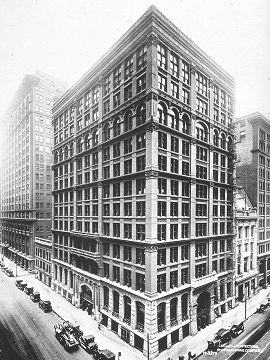Chicago school of architecture
Above: The Home Insurance Building by architect William Le Baron Jenney, which some regard as the first skyscraper in the world, was built in Chicago in 1885 and was demolished in 1931.
Chicago's architecture is famous throughout the world and one style is referred to as the Chicago School, also known as 'commercial style'. In the history of architecture, the Chicago School was a school of architects active in Chicago at the turn of the 20th century.
They were among the first to promote the new technologies of steel-frame construction in commercial buildings, and developed a spatial aesthetic which co-evolved with, and then came to influence, parallel developments in European Modernism.
While the term Chicago School is widely used to describe buildings in the city during the 1880s and 1890s, it has been disputed by scholars, in particular in reaction to Carl Condit's 1952 book The Chicago School of Architecture.
Historians such as H. Allen Brooks, Winston Weisman and Daniel Bluestone have pointed out that the phrase suggests a unified set of aesthetic or conceptual precepts, when, in fact, Chicago buildings of the era displayed a wide variety of styles and techniques.
Contemporary publications used the phrase 'Commercial Style' to describe the innovative tall buildings of the era rather than proposing any sort of unified school.
Distinguishing features of the Chicago School include the use of steel-frame buildings with masonry cladding (usually terra cotta), large plate-glass windows and limited exterior ornamentation. Sometimes elements of neoclassical architecture are used in Chicago School skyscrapers.
Many Chicago School skyscrapers contain the three parts of a classical column. The first floor functions as the base, the middle stories, usually with little ornamental detail, act as the shaft of the column, and the last floor or so represent the capital, with more ornamental detail and capped with a cornice.
The 'Chicago window' originated in the school. It is a three-part window consisting of a large fixed center panel flanked by two smaller double-hung sash windows. The arrangement of windows on the facade typically creates a grid pattern, with some projecting out from the facade forming bay windows. The Chicago window combined the functions of light-gathering and natural ventilation; a single central pane was usually fixed, while the two surrounding panes were operable. These windows were often deployed in bays, known as oriel windows, that projected out over the street.
Architects associated with the Chicago School include:
- Henry Hobson Richardson.
- Dankmar Adler.
- Daniel Burnham.
- William Holabird.
- William LeBaron Jenney.
- Martin Roche.
- John Root.
- Solon S. Beman.
- Louis Sullivan.
- Frank Lloyd Wright started in the firm of Adler and Sullivan but created his own Prairie Style of architecture.
Source: Boundless. “Chicago School of Architecture.” Boundless Art History. Boundless, 21 Jul. 2015.
[edit] Related articles on Designing Buildings Wiki:
- Archigram.
- Architectural styles.
- Art Deco.
- Art Moderne.
- Arts and craft movement.
- Bauhaus.
- Beaux Arts style.
- Chicago Architecture Foundation River Cruise - review.
- Classical orders in architecture.
- Classical Revival style.
- Commercial style.
- Concept architectural design.
- English architectural stylistic periods.
- Form follows function.
- International Style.
- Italian Renaissance revival style.
- Polite architecture.
- Prairie School style.
- Spanish Colonial revival style.
- Tudor revival style.
- Vernacular architecture.
Featured articles and news
CIOB report; a blueprint for SDGs and the built environment
Pairing the Sustainable Development Goals with projects.
Latest Build UK Building Safety Regime explainer published
Key elements in one short, now updated document.
UKGBC launch the UK Climate Resilience Roadmap
First guidance of its kind on direct climate impacts for the built environment and how it can adapt.
CLC Health, Safety and Wellbeing Strategy 2025
Launched by the Minister for Industry to look at fatalities on site, improving mental health and other issues.
One of the most impressive Victorian architects. Book review.
Common Assessment Standard now with building safety
New CAS update now includes mandatory building safety questions.
RTPI leader to become new CIOB Chief Executive Officer
Dr Victoria Hills MRTPI, FICE to take over after Caroline Gumble’s departure.
Social and affordable housing, a long term plan for delivery
The “Delivering a Decade of Renewal for Social and Affordable Housing” strategy sets out future path.
A change to adoptive architecture
Effects of global weather warming on architectural detailing, material choice and human interaction.
The proposed publicly owned and backed subsidiary of Homes England, to facilitate new homes.
How big is the problem and what can we do to mitigate the effects?
Overheating guidance and tools for building designers
A number of cool guides to help with the heat.
The UK's Modern Industrial Strategy: A 10 year plan
Previous consultation criticism, current key elements and general support with some persisting reservations.
Building Safety Regulator reforms
New roles, new staff and a new fast track service pave the way for a single construction regulator.
Architectural Technologist CPDs and Communications
CIAT CPD… and how you can do it!
Cooling centres and cool spaces
Managing extreme heat in cities by directing the public to places for heat stress relief and water sources.
Winter gardens: A brief history and warm variations
Extending the season with glass in different forms and terms.
Restoring Great Yarmouth's Winter Gardens
Transforming one of the least sustainable constructions imaginable.
























